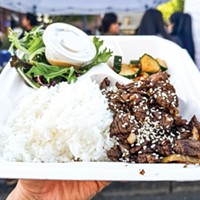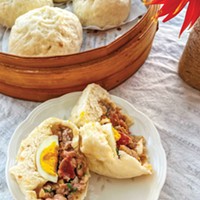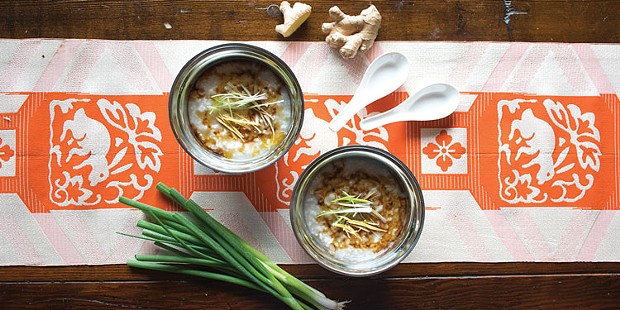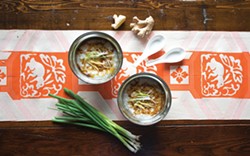After the Feast, Congee
For leftovers and hangovers
By Jennifer Fumiko Cahill [email protected] @jfumikocahill[
{
"name": "Top Stories Video Pair",
"insertPoint": "7",
"component": "17087298",
"parentWrapperClass": "fdn-ads-inline-content-block",
"requiredCountToDisplay": "1"
}
]
Maybe you're a more disciplined person than I am. Maybe after the preparations, the cooking, the gorging, the food coma and the dish washing that follow a holiday meal, you can spring up from the bed/couch/floor and begin chopping ingredients for turkey soup. Maybe, like my Sicilian mother-in-law, you're already melting butter for a Tetrazzini while I'm still taking shallow breaths and pawing at leftover pie. Hell, maybe you ate in moderation and aren't nursing a food hangover that will likely last until the next celebration.
But if you're like me and all you can muster after a holiday dinner is bagging the bones and tossing them in the freezer, there's still something wonderful — and stupidly easy — you can do with the remains of a roasted chicken, duck or even a turkey. (Yes, reader with a stack of rotisserie chicken containers forming a tower in your recycling bin, even the $6.99 bird you pick up on Friday nights.) It's cheap, uses up the very last of the carcass after a holiday meal and is gentle on your overtaxed stomach — which is important when you're shakily staring down a month of festivities.
In China rice porridge is called congee or jook. In parts of India it's kanji. In Laos it's khao piak. In Japan it's okayu. But all over Asia, people cook rice into a restorative porridge — with or without fish, meat or bones — adding a few toppings for a simple, comforting meal, morning or night. The Chinese version might be served with fried dough, ginger, soy sauce and green onions. It can be soup-like or similar to a soft risotto. Because this humble dish is so comforting and easily digested, it's also what we feed the sick.
When I was a child, hamming it up with my symptoms, my grandmother made me plain, thick rice-and-water okayu to eat in bed, dropping a soft, pickled Japanese plum on top. If you grew up in an Asian family, you likely ate a version — with Jasmine rice? an egg? crispy shallots? coconut? — that remains the ur-porridge you'll always crave and always return to, no matter how many versions you learn to love. I've made our family's iteration for my children when they were ill, for friends who were hungover and for myself and the cat when I was broke. And after Thanksgiving, some form of rice porridge bubbles on the stove in many an Asian-American kitchen.
When using turkey, I break toward a thinner Chinese version with ginger that can stand up to the strong flavor of the meat. And I prefer to use the larger bones — the legs, thighs, whole wings and back, skipping the ribs and smaller bones that might get lost in the rice or be difficult to scrape clean when you're ready to take them out. And if you stuff your bird, the accompanying herbs in the cavity can dominate the porridge.
Did you polish off/send everyone home with the turkey? Make the congee anyway, skipping the bones, and recover from the excesses of the holiday season. You can use either long grain or short grain white rice. However, brown rice will yield something completely different, which you are welcome to try for whatever health reasons you have as long as I never have to know about it and you never tell anyone you got the recipe from me. Deal? Deal.
Turkey, Chicken or Duck Congee with Ginger
Serves 4-6
Ingredients:
1 cup uncooked white rice
8 cups cold water
bones of a roasted turkey, meat removed
2 teaspoons salt
1 inch fresh ginger, skinned
3 green onions, finely chopped or julienned
sesame oil
soy sauce
sliced meat for garnish (optional)
In a large pot, place the bones in the cold water with the rice and bring it to a boil. Meanwhile, slice half the ginger into thick circles and add them to the pot with the salt. Slice the rest of the ginger into the thinnest matchsticks possible and set them aside.
Once the water comes to a boil, lower the heat and let it simmer for 45-60 minutes, depending on how soft you like the rice, stirring frequently to keep it from sticking to the bottom of the pot. Once the rice reaches your preferred consistency, remove it from the heat and ladle it into bowls. Scrape any remaining meat off the bones and into the rice. Garnish with the slivers of ginger and green onion, and add a swirl of sesame oil and soy sauce to taste.
Jennifer Fumiko Cahill is the arts and features editor at the Journal. Reach her at 442-1400 extension 320 or [email protected]. Follow her on Twitter @JFumikoCahill.
Speaking of...
-

What's Good at the Friday Night Market
Jun 6, 2024 -

Grandpa's Gifts
Nov 2, 2023 -

Dumplings and Tea at the Carwash
Mar 31, 2023 - More »
more from the author
-
What's Good
New Digs for Il Forno and Obento
- Jul 11, 2024
-
Maxxxine's Bloody Point
- Jul 11, 2024
-
Il Forno in Fortuna
- Jul 8, 2024
- More »


































